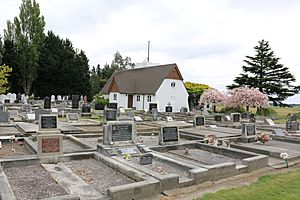Woodend, New Zealand facts for kids
Quick facts for kids
Woodend
|
|
|---|---|
|
Minor urban area
|
|

Woodend in 2010
|
|
| Country | New Zealand |
| Region | Canterbury |
| Territorial authority | Waimakariri District |
| Ward | Kaiapoi-Woodend Ward |
| Community |
|
| Electorates |
|
| Area | |
| • Total | 5.99 km2 (2.31 sq mi) |
| Elevation | 14 m (46 ft) |
| Population
(June 2023)
|
|
| • Total | 4,550 |
| • Density | 759.6/km2 (1,967/sq mi) |
| Postcode |
7610
|
Woodend is a town in the Waimakariri District of New Zealand. It is located in the Canterbury Region on the South Island. The town might have been named because it was on the edge of a large forest called the Maori Bush. Another idea is that it was named after an early settler, Thomas Wooding.
Woodend sits between two rivers, the Waimakariri and the Ashley / Rakahuri. It is about 6.6 kilometres north of Kaiapoi and 6.3 kilometres east of Rangiora. The town of Pegasus is also very close by. Woodend is about 25 kilometres north of central Christchurch and is part of Christchurch's wider city area.
The town has a population of 4,550 (June 2023). Woodend is close to Woodend Beach, a great spot for activities. You can go swimming, surfing, walking, running, and even horse riding there. The Tūhaitara Coastal Park is nearby, offering trails for walking and mountain biking. The Tutaepatu Trail connects Woodend Beach, Pegasus Town, and Waikuku Beach.
Contents
Woodend's Weather
The warmest months in Woodend are January and February. During these months, the average high temperature is around 23°C. The coldest month is July, with an average high temperature of 11°C. The amount of rain changes throughout the year. It rains least in January and April, with about 34mm. July is the wettest month, with around 63mm of rain.
Learning in Woodend
Woodend School is the only school in the town. It is a state school for both boys and girls. It teaches students from primary school age up to Year 8. The school has a decile rating of 8, which shows it is in a well-off area. As of February 2024, there are 451 students attending Woodend School.
How Many People Live Here?
Statistics New Zealand defines Woodend as a small urban area. It covers about 5.99 square kilometres. As of June 2023, the estimated population of Woodend was 4,550. This means there are about 760 people living in each square kilometre.
In 2018, the town had a population of 2,784 people. This was a small increase from 2,739 people in 2013. There were 984 households in Woodend. For every 100 females, there were about 103 males. The average age of people in Woodend was 43.0 years. About 19% of the population was under 15 years old.
Most people in Woodend are of European descent (93.9%). About 9.8% identify as Māori. Smaller groups include Pasifika (1.6%) and Asian (1.7%). About 15.6% of people in Woodend were born outside New Zealand.
When asked about their religion, 57.5% of people said they had no religion. About 31.0% were Christian. A small number followed Māori religious beliefs (0.8%), Hindu (0.1%), or Buddhist (0.2%).
Ravenswood: A Growing Community
A large new housing area called Ravenswood is being built on the northern edge of Woodend. The first families moved into their new homes in 2019. When it is finished, Ravenswood is expected to have 1500 homes. This will make Woodend much larger. The new area will also have 13 hectares of shops and businesses. These will include a petrol station, a fast food restaurant, and a supermarket. The Ravenswood project started in 2014 but faced delays after the death of the person who was developing it, Bob Robertson.
Important Buildings
Saint Barnabas Church
Saint Barnabas is the local Anglican Church for Woodend and Pegasus. It replaced an older church that was built on the same spot in 1859–60. The old church had to be taken down because of dry rot. The current church was designed by an architect named Cecil Wood in 1930. It officially opened in June 1933. In 1993, new rooms for meetings and a kitchen were added. These additions were designed by architect Don Donnithorne.
Woodend Methodist Church
The Woodend Methodist Church was built in 1911. It was damaged during the 2010–2011 Christchurch Earthquakes. Luckily, it has since been repaired and is now back in use.
Getting Around Woodend
State Highway 1, a major road, goes right through the middle of Woodend. More and more cars use this road every year. In 2019, about 20,000 cars drove through Woodend each day. This caused problems for local people. In February 2020, some residents even blocked State Highway 1 to protest the traffic.
In September 2020, traffic lights that the New Zealand Transport Authority (NZTA) had promised were delayed. The NZTA expects the number of cars to double over the next 30 years. Their preferred plan is to build a new four-lane bypass road. This bypass would connect to the current motorway at Lineside Road and go all the way to the entrance of Pegasus town. However, the New Zealand government has not yet provided money for this bypass. In March 2021, it was only listed as a future project for Canterbury.
Famous People From Woodend
- Anton Cooper (born 1994), a champion cross-country cyclist. He won the World Under 23 Cross-country championship.
- Catharine Squires, also known as Kate, was a preacher for the Plymouth Brethren religious group.



